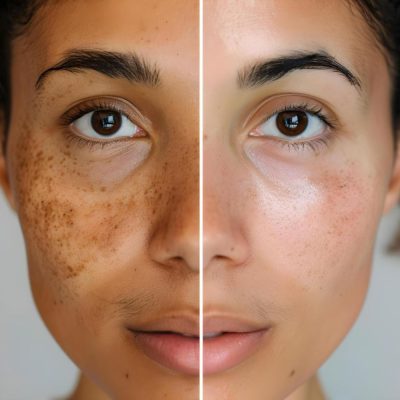Hyperpigmentation
Hyperpigmentation is a common skin condition characterized by darkened areas of the skin. It can affect any skin type. It occurs when the skin produces excess melanin which is the pigment responsible for skin colour. Although hyperpigmentation is usually harmless, it can be a cosmetic concern for some individuals. At SkinAccess Clinics, we provide comprehensive, personalized treatment plans to manage hyperpigmentation and restore an even skin tone.

What is Hyperpigmentation?
Hyperpigmentation presents in various forms, including melasma, age spots (also called liver or sun spots) and post-inflammatory hyperpigmentation (PIH). It is known to affect any part of the body but is most commonly found on the face, hands and other areas frequently exposed to the sun. It can be triggered by various factors including hormonal changes, sun exposure, skin injuries and even certain medications. Generally, hyperpigmentation is not harmful, however, it can impact an individual’s confidence and self-esteem. For effective management, it is crucial to understand the underlying causes and the available treatment options.
Symptoms of Hyperpigmentation
The primary symptom of hyperpigmentation is the appearance of darkened areas or patches on the skin. These patches can develop anywhere on the body and can vary in size. Some common symptoms include
Dark Spots or Patches
These areas are usually brown, black or grey and appear on the face, neck, hands and other areas prone to sun exposure.
Uneven Skin Tone
It often leads to an uneven skin tone, where some areas of the skin appear darker than others.
Freckles or Lentigines
These are small, dark spots that tend to become more prominent with sun exposure.
Typically, hyperpigmentation is not accompanied by any other discomfort or pain, making it a primarily cosmetic concern.
Causes of Hyperpigmentation
Hyperpigmentation can be caused by various factors. Understanding the underlying cause is the key to its effective treatment.
Prolonged sun exposure is one of the most common causes of hyperpigmentation. Ultraviolet (UV) rays stimulate the production of melanin which causes dark spots and patches on the skin.
Hormonal fluctuations, particularly during pregnancy or due to the use of birth control pills can trigger melasma, a type of hyperpigmentation that affects the face.
An injury or inflammation to the skin such as cuts, acne or eczema can cause dark spots in the affected area.
Certain medications like chemotherapy drugs can cause hyperpigmentation as a side effect.
Some conditions such as Addison’s Disease and Hemochromatosis, can cause hyperpigmentation as a symptom.

Diagnosis of Hyperpigmentation
Diagnosing hyperpigmentation requires a thorough examination by a dermatologist. They will assess the skin and review the patient’s medical history. At times, UV light may be used to examine the depth of the pigmentation. In some cases, if a diagnosis is unclear, a skin biopsy may be required to rule out other conditions.
Management and Treatment of Hyperpigmentation
Treatment requires a tailored approach, depending on the cause, severity and location of the dark spots. At SkinAccess Clinics, we offer a range of treatments designed to lighten dark spots and even out skin tone.
➥ Topical Treatments: Creams and ointments may be prescribed to help reduce melanin production and lighten dark spots.
➥ Chemical Peels: Superficial chemical peels help to exfoliate the skin and reduce the appearance of hyperpigmentation.
➥ Laser Therapies: Advanced treatments like laser resurfacing target and break down excess melanin, helping to fade dark spots.
➥ Microdermabrasion: This non-invasive procedure exfoliates the skin, promoting cell turnover and reducing hyperpigmentation.
➥ Sun Protection: Daily use of broad-spectrum sunscreen with an SPF of 30 or higher is crucial for managing hyperpigmentation. It helps to protect the skin from further sun damage.
➥ Skincare Routine: Following a proper skincare routine with products containing vitamin C, niacinamide and kojic acid helps brighten the skin and prevent new dark spots from forming.
